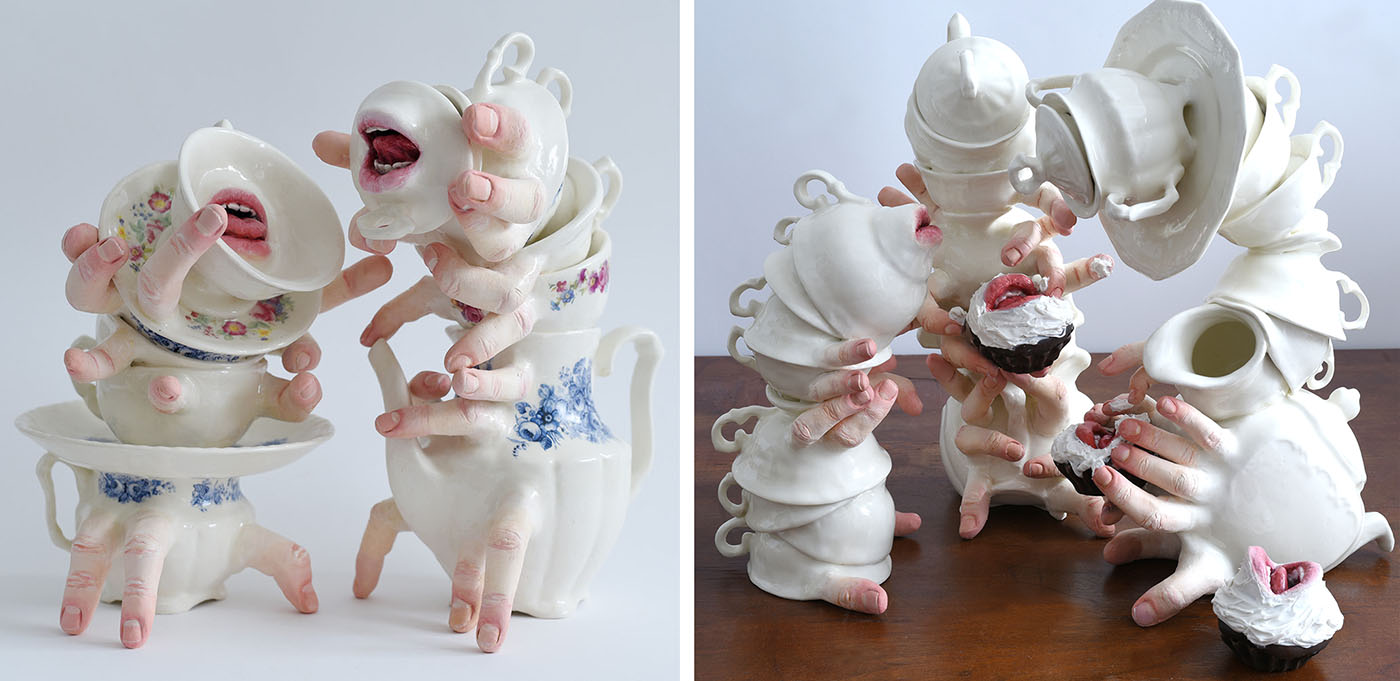
David Capps
Stoicism and Perceptual Image
In a collection of work featured at the Beinart Gallery in Brunswick, Australia, entitled “All Things Sweet and Painful,” artist Ronit Baranga offers an unsettling alternative to the “still life” with her white clay sculptures. These small ceramic pieces feature daily utensils, plates, bowls, teacups, cupcakes, pies, yet overgrown with mouths, anthropomorphized with fingers grasping from what would otherwise be an ordinary contour of the object. As the thematic is described on the website: “On a deeper psychological level, Baranga addresses the complex relationship we have with luxuries, especially with foods: the mix of need and the insatiable hunger for more — more sugar, more attention, more love. There is a constant push against the boundaries of rational consumption, craving the sugar rush, forever tempted to go overboard.”
It can seem upsetting even, in the way that good art sometimes causes a scandal; yet the art in question can reflect an underlying psychological realism — as the artist remarks in the film series Israeli Creators by Shachaf Dekel, “…You always have an undercurrent of violence and pain and joy and tranquility….It’s never all beautiful or all bad.” Especially in connection to one major aesthetic of ceramics, its elegant simplicity — even to the point of skirting the line between art and craft by becoming “merely functional” — work like this threatens instead to expose the hidden horrors of the “inanimate” object, to suggest that even in the most functional there is an element of the wild, or the insane, staring back at us, groping its way up the neat table cloth by the tea set to reveal that even in our most steadfast daily rituals, there is the possibility of disruption and despair.
Viewing the collection as a whole, one is struck first by the tactile spell associated with each piece — there are fingers clutching, pincing, strutting, and in some cases supporting, serving as “legs” of a kind of hybrid creature under the strain of its own weight. Each piece in the collection seems completely idiosyncratic, to have its own way of being, as opposed to having been divided from its own species or else sprung together, juxtaposing disparate parts in such a way that does not underwrite an organically emerging being (e.g. compare an image of Pegasus as a horse plus wings).
In this way the pieces are reminiscent of the surrealist artist Yves Tanguy, whose own compositional repertoire included figures possessed of an individuality; yet while in Tanguy’s case, one is unable to specify even a vague idea of what his individuals consist of, Baranga does provide features which readily connect the human realm (mouths, fingers, lips, etc.) to the realm of artifact (tea set, cup, plate) — even to the extent that, when viewing the collection as a whole one senses in the figuration of the pieces a macabre recapitulation of a decadent soirée.
As the quotes above suggest, I think we find these works somewhat unsettling in part because they reflect back to us in an immediate way certain ideas we’d rather shelf: ideas of appetite, temptation, satiation, distraction, ennui, the fading repetitions of delight, even regret. It is characteristic of humans to do this, to push away these ideas and the negative emotions associated with them, focusing only on the objects at hand — the cupcake, the fork, sipping Earl Grey from the fine porcelain lip, unaware of our own lip that sips.
One difficulty about experiences, however, whether or not they are apt to pervert reason, is that they tend to not have clearly demarcated durations.
What seems “ugly” is often in this way opposed to what lacks sumptuous quality, that hard to pin down veneer or “aura” of the artwork that Walter Benjamin wrote so glowingly about. Yet such a pushing away is as beautiful as it is inaccurate. To develop why this is, and better appreciate the aesthetic of the present collection that rejects such repulsion, I propose we reflect on a few delectable tidbits of wisdom from the Stoic tradition. We turn first to a key passage in Marcus Aurelius’ Meditations (from Marcus Aurelius, Meditations, VI.13, trans. G.M.A. Grube (Hackett: 1983), p. 50.)”
How useful, when roasted meats and other foods are before you, to see them in your mind as here the dead body of a fish, there the dead body of a bird or pig. Or again, to think of Falernian wine as the juice of a cluster of grapes, of a purple robe as sheep’s wool dyed with the blood of a shellfish, and of sexual intercourse as internal rubbing accompanied by a spasmodic ejection of mucus. What useful perceptual images there are! They go to the heart of things and pierce right through them, so that you can see things for what they are. You must do this throughout life; when things appear too enticing, strip them naked, destroy the myth which makes them proud. For vanity is a dangerous perverter of Reason, and it is when you think you preoccupations most worthwhile that you are most enthralled. Look at what Crates said even of Xenocrates.
The suggestion, according to this passage anyway, seems to be that for each “image” (read: experience) which, through its sensory quality, tempts one away from “reason,” there is an associated “perceptual image” which represents the initial image as it is in itself, at the time it is experienced. Thus, at the time Aurelius is about to indulge in feasting upon the honeyed suckling pig, while his embattled troops are served some lesser fare, there is for this experience the associated perceptual image of a dead pig (or less granularly, a dead animal) which serves as an important reminder to not become overly intoxicated by the experience at hand.
What would be wrong with that? The trivial answer is that allowing the senses to take over when immersed in any given experience would be too Epicurean, too reflective of a life that holds pleasure, and not virtue — which need not always be accompanied by pleasure — as the fundamental good. To do so wouldn’t be in the spirit of Stoicism. The less trivial answer, and one reason for the philosophical rift between Epicureanism and Stoicism, is the recognition that a life tied to pleasure — even if understood merely as a sort of tranquil absence of pain — as the highest good, is a life tied to the sort of state of mind which is held hostage to the contingencies of the world, and that is something one has no direct control over.
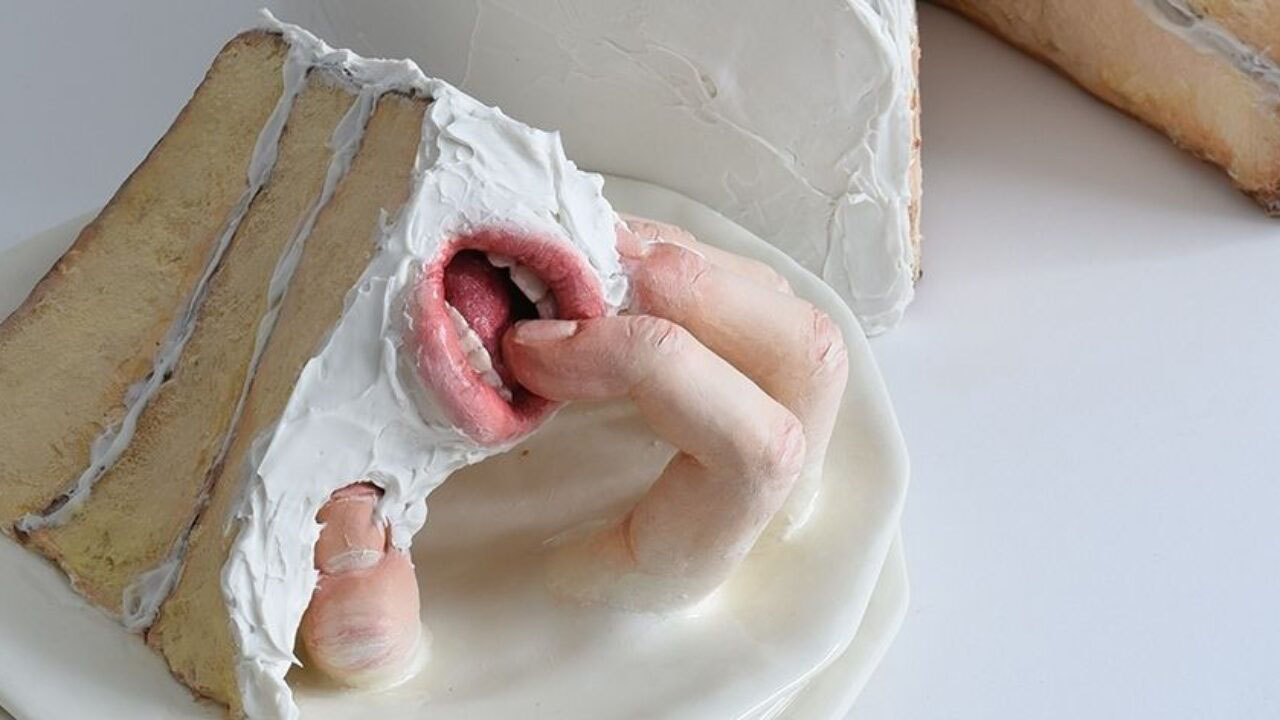
I want to highlight a couple other ideas surrounding the perceptual image, however. First is that while in this passage each perceptual image is indexed to a time which coincides with the occurrence of the experience, this need not be the case, and arguably isn’t. Here are two senses in which the dead pig really is Aurelius’ sumptuous dinner on the battlefield: the same biological description serves partly to characterize both, and a causal sense that if there were no dead pig there would be no sumptuous dinner. One difficulty about experiences, however, whether or not they are apt to pervert reason, is that they tend to not have clearly demarcated durations.
One could say that almost any given experience is blurry about the edges. If, for example, I am playing a game of chess, and suppose I’m in the development stage of the game, I might be most focused on giving piece activity to my “bad bishop”; of course this experience of desiring to, say, liberate my bishop from a blocking pawn is part of the experience of the development stage of the game; but as any chess player realizes, there is no definite point at which this needs to occur. Indeed, certain chess games appear to seamlessly transition from the opening stage to the end game, so that one would be hard pressed to construe the condition for this particular experience ending by associating the completion of development with the entry into the middle game. Now, analogies are apt to mislead, which is why at this point I’d encourage the reader to reflect on other experiences — watching a sunset, attending a concert, writing a poem, etc. and for the editors out there, reading the present essay.
If many experiences which tempt us away from our goals (be it a state of calm reflected in the judicious operations of Reason, or whatever—we need not adopt Aurelius’ own goals to make the point), and we recognize that these experience need not have a definite beginning or end, then we can drop the way that Aurelius indexes the associated perceptual images to the time of the experience. When, for example, I see the lush oak tree dropping acorns on the path I jog and wish to savor the moment, the reserve I can experience which recognizes the fragility of life might be better expressed by reflecting on how the great oak tree once was itself an acorn, as opposed to reflecting on the bark and seed lying at my feet.
In other words, we might identify a certain savory experience as having two causal poles described in terms of the causal origin and future, respectively, of the experienced object. (How far into the future or past can we focus—well, one wants to say “not too far” otherwise the objects of experience all turn out to be the same — ending in a state of flat entropy). Not that this means excluding Aurelius’ own tact of perceptual images; the two ideas are complementary.
Consider the famous Zen story about two monks who were once walking on their way to the temple. Upon seeing a woman stumbling in the rain (there was a heavy storm) one monk decided to pick her up and carry her across a stream. After they reached the temple, the other monk turned to him and reprimanded: ‘How could you have carried her across the stream — is not one of our vows to not be tempted by the flesh?’ To which the other monk replied: “I left her back at the path. It seems you are the one who is still carrying her.” The point of the story in this context is not just that memory itself can be the sort of internal experience which is subject to attachment (the Buddhist analogue to the Stoic “perverter of Reason”), it is that the severance of attachment can be a process.
This brings me to a second point to highlight about Aurelius. As the editor’s footnote to Bk. VII.2 “Look upon things as you used to look upon them, for to do so is to live anew” puts nicely, there is an emphasis on the continual reflection of what Aurelius perceptually imagines:
Images in the mind, [phantasia], are of many kinds, good or bad, and they motivate actions. They are good if they are under the control of the directing mind, in accordance with the right principles, and lead to the right kind of actions; they are bad when they reflect passions and unnecessary desires, and thus lead to the satisfaction of those passions and desires. Marcus means that the continual application of right principles to action, by way of the right mental images, keeps those principles and doctrines alive.
Of course, what makes a given mental image “the right” mental image to achieve Aurelius’ purpose is addressed in passages such as the one I began with, where the right mental image is a perceptual image that provides the essence or matter of the experience. Additionally, in Bk.III 2, Aurelius underscores his point by emphasizing that we often suffer from a sort of myopia when we focus on the incidental features of experiences without seeing them in connection to Nature as a whole:
For example, when a loaf of bread is being baked, some parts break open, and these cracks, which are not intended by the baker’s craft, somehow stand out and arouse in us a special eagerness to eat; figs, too, burst open when they are very ripe, and the very closeness of decay adds a special beauty to olives that have ripened on the tree. The same is true of ears of wheat as they bend to the ground, of wrinkles of a lion’s brow, of the foam flowing from a boar’s mouth, and of many other things. Looked at in themselves they are far from attractive, but because they accompany natural phenomena they further adorn them and attract us. As a result, the man of feeling and deeper understanding of the phenomena in Nature as a whole will find almost all these incidentals pleasantly contrived…. (Ibid p. 18)
Now these features of the objects of experience Aurelius is calling incidental seem to me the very stuff of life; and perhaps different individuals will parcel out which features are “incidental” and which are “essential” differently. But let it not obscure the main point here, which is that in addition to severing attachment and mitigating our own mental turbulence by focusing on the matter and far causal poles of our experiences, we can also facilitate these goals by contextualizing our experiences and their objects as parts of various systems — biological, anthropological, mythological, sociological, and perhaps in terms of the widest system, Nature — as Aurelius states at the end of the passage: ‘Many such things will not appeal to everyone, but only to the man who has come to be genuinely at home wit Nature and her works’. (Ibid p. 19)
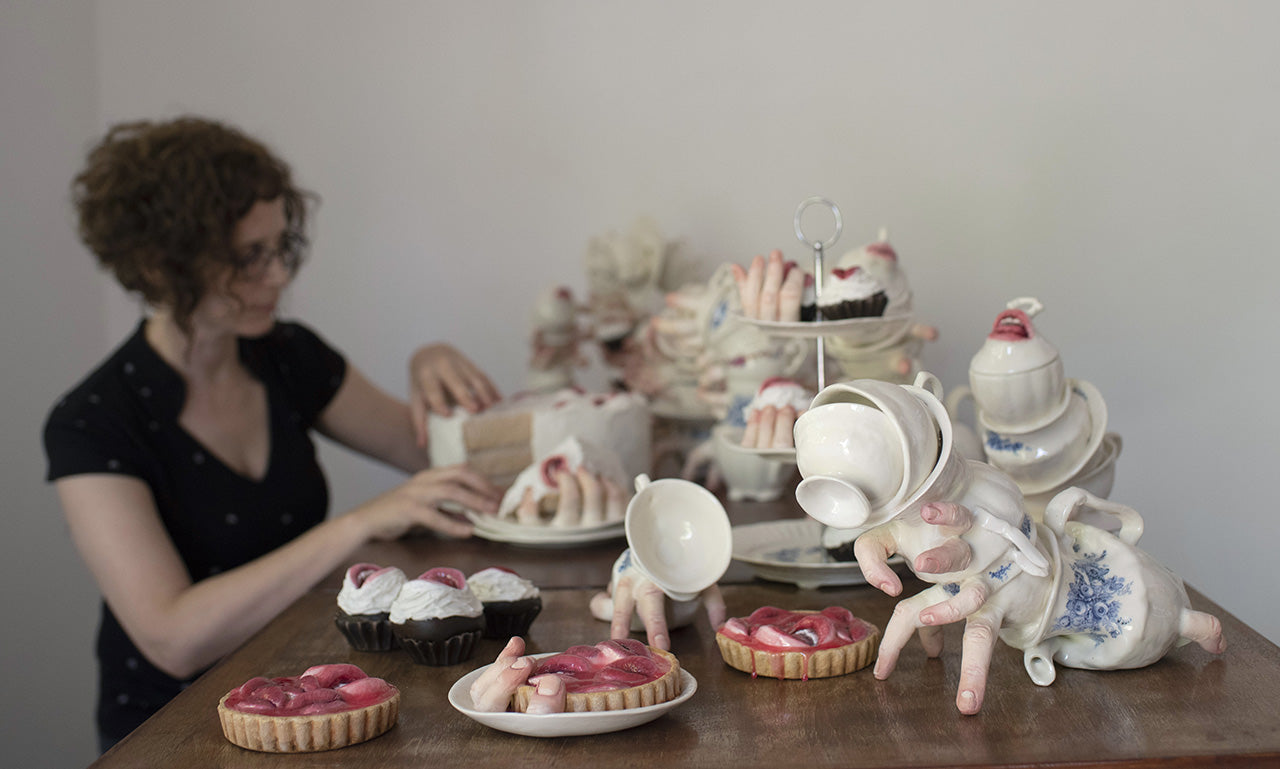
Now that I have explored a few facets about perceptual images in Aurelius, let’s return to the Baranga exhibit, “All Things Sweet and Painful” and its hard-to-pin-down aesthetic. We can begin by making an observation about the collection as a whole before relating specific pieces to the concepts of perceptual image and experiential poles.
In the first place one could say that the collection as a whole is an artistic deconstruction of the teatime experience, where the “matter” that makes it up are the individual pieces in the collection, each one highlighting a certain aspect of the experience. Now when we gather the pre-reflective data for that experience there are definitely associations we make: that it’s habitual (as in the British ceremony), sociable and pleasant, decadent at times, perhaps inessential when compared to the mainstays of the diet.
It isn’t expected that in an artwork there will be an exact mapping between the features of the experience and the elements of the collection, but there is an interplay between them, and this interplay may be understood in terms of the Stoic practice of reflection upon the perceptual image.
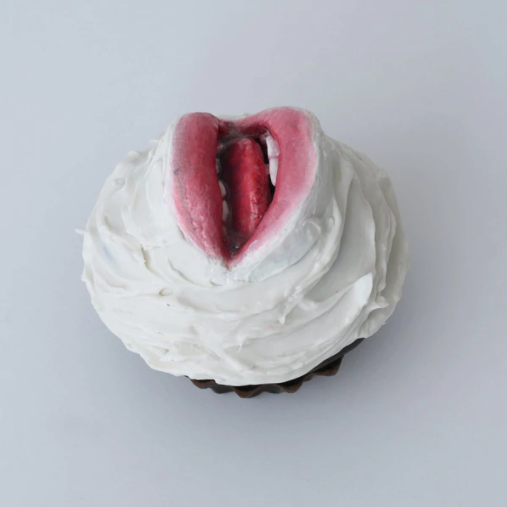
We noted before that Aurelius views the perceptual image as one which helps one ward against the perversion of reason by either focusing on the matter, or essence, of the experience, or its parthood relation to a wider system, or, as I suggested, its placement along the causal poles of the experience. Also recall that in this context we can drop from the picture the overall Stoic aim of allowing reason to exist unfettered by the passions and so more conducive to a virtuous life (and shouldn’t we drop this, if art is allowed to be irrational?), without losing what is important to the process of reflection on perceptual images. The more modest goal here, I might venture forth, is to reflect on our own habits, the ways we give in to consumerist ideals, and the way attachments to our own satiation might mask a deeper psychological turmoil.
I’ll now focus on a few works that stood out to me as thematic of Aurelius’ perceptual images. One is called ‘Cupcake #6’; this clay sculpture depicts a cupcake with swirls of white frosting which appear quite deliciously rendered, but instead of tapering to a nice, neat cupcake top, a partially opened mouth appears, rifting it with protruding lips and a visible tongue between teeth which do not seem deliberately bared so much as accessories to taking a bite.
The longer one focuses on the image, the more it seems to disconnect from the gustatory experience one associates with eating a cupcake; one begins to wonder whether the mouth is tearing its own face in two, or whether the resemblance between lips and lady bits isn’t in some way the real meaning of the rigid, formal tea ceremony, the four pm “high tea” Teapig-squanched biscuit notwithstanding.
If one pole of the experience of indulging in the cupcake is visual — we look at the cupcake, we begin to salivate perhaps, we see ourselves grasping the choicest one even before the moment arrives — the other pole is tactile and gustatory — we unwrap the cupcake from paper, we might lick the frosting if we are alone, if we are not, we daintily take the first bite. Yet where does it all lead? Will we ever be satisfied?
Aurelius himself might encourage us to reflect on the “matter”: frosting, sugar, paper. Yet the artist treats the perceptual image by bringing the two causal poles — tactile and visual — of the experience together into one single object. If we wanted to talk about its matter, we could: a mouth composed of lip, and teeth and tongue. The matter of a lip qua lip is nothing but itself, it remains the same lip whether made of flesh and blood or clay. Yet its matter is also integrated into the matter of the cupcake, which we can understand in terms of the same underlying stuff.
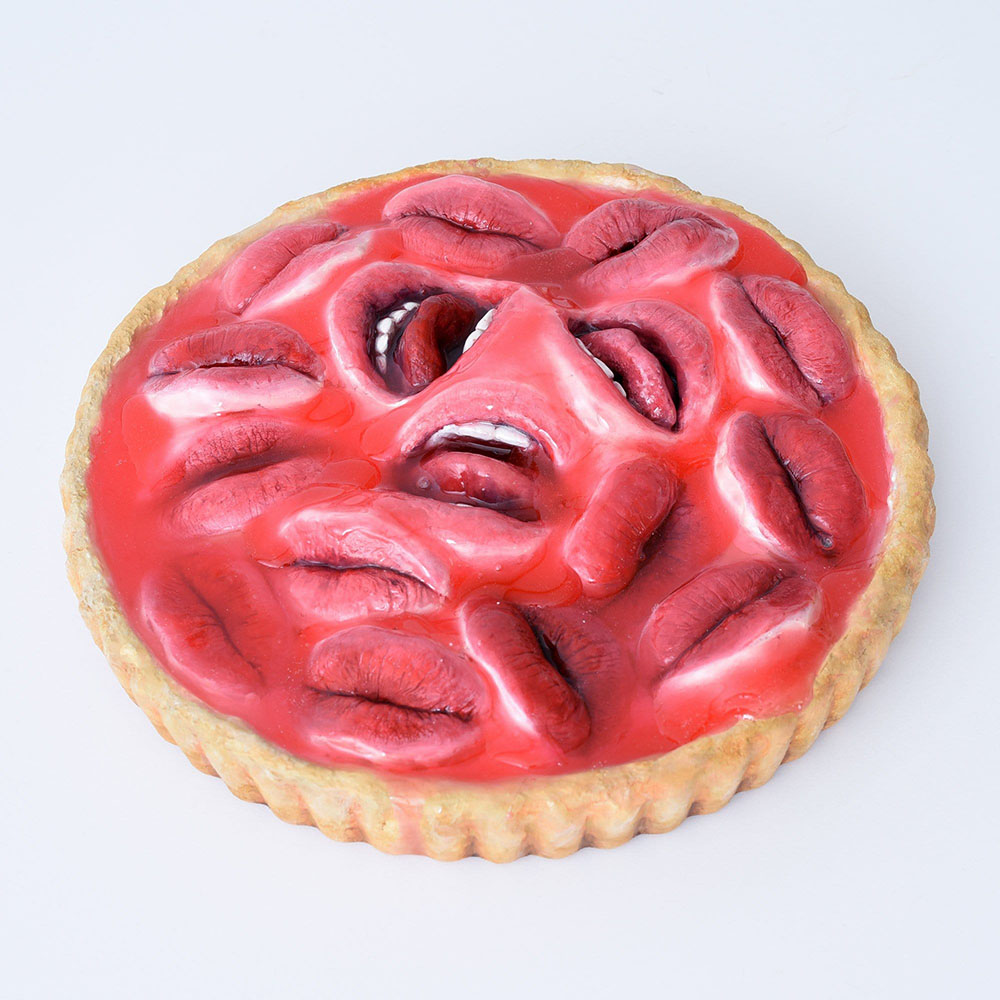
Reflection on the perceptual image, in turn, may lead the viewer to dissociate from his or her own experiences of satiation, since by bringing together these two poles of experience into one main knot, the artist disrupts the experience from having its normal effect — that momentary feeling you get after tasting and swallowing the first bite of the cupcake.
What applies to the experience we actually have applies as well to the anticipations of experiences, especially where obsession can be involved, in that there can be just as much attachment to the expectation of a pleasure as to its occurrence. In a consumerist culture saturated with Photoshopped images of cupcakes, steaks and various delicacies, I think we would do well to remember Baranga’s works as a way to untie ourselves from our own poorly regulated expectations, even if the untying isn’t derived (nor should we expect it to be) from a particular ethical system so much as a subjective, confrontational reflection on the perceptual image.
That we should not forget that these experiences with satiation and excess are a collective phenomenon is brought out by ‘Pie #4’ which features what would otherwise look like a cherry pie, were it not for the many mouths — some mid bite, mid chew, others mid swallow, which brim along the surface of the pie. Again, the technique of bringing the visual and tactile causal poles of experience together is illustrated here, but there is a collective element as well — the many people sharing a pie become the many mouths each enmired in their own private vice, as the mouths are blind to each other and teem across the surface of the pie.
For me this sculpture is reminiscent of the mumbling mouths in Dante’s Inferno which mock and petition him as he walks across, in that they each have the same sort of disconnectedness from the individual. This is only one interpretation, however, as the work might also be read in terms of a single individual’s consumption of the pie, so that the mouths are melded together to reveal all at once the discrete feeding stages, perhaps rationalizations, of personal excess.
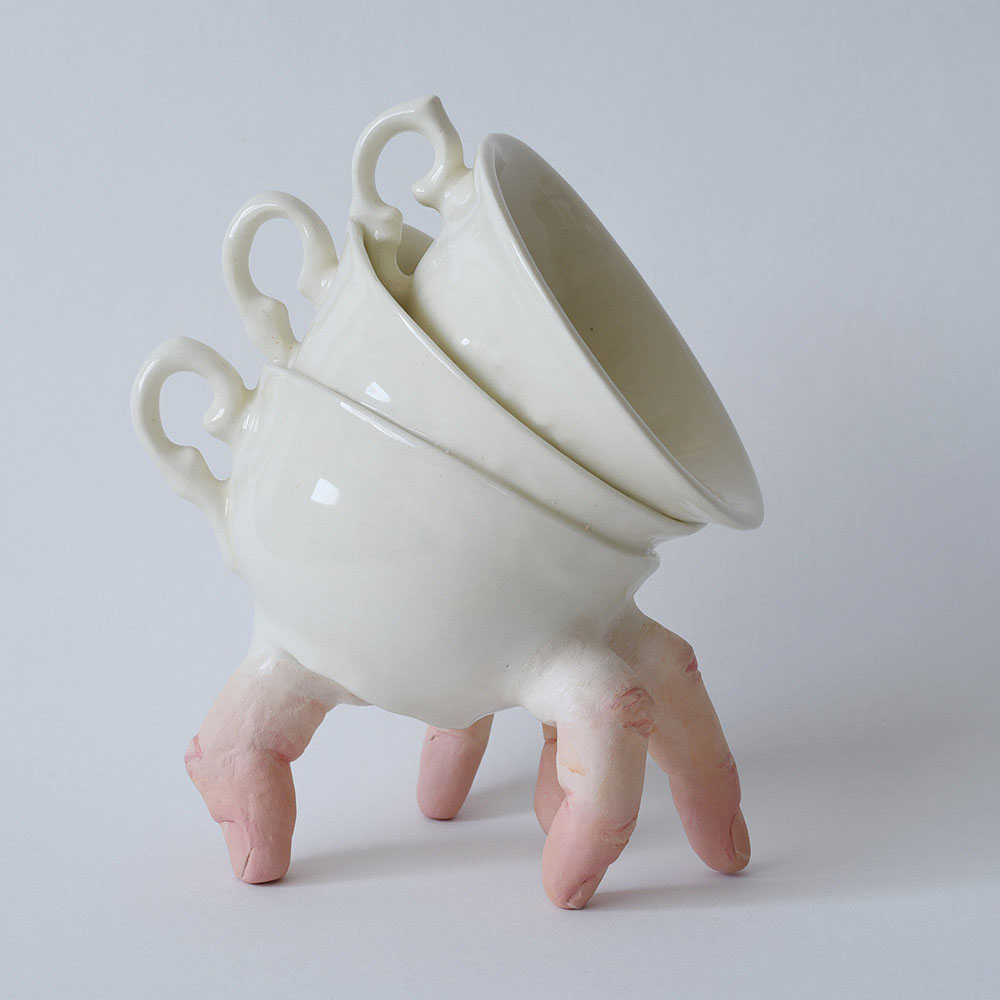
Finally there are the ‘Hybrid Tea Set’ pieces, of which the one that stands out most to me is #15. Here the piece consists of three tea cups, stacked atop one another, as if they have been hastily collected after the tea party has concluded, yet fingers protrude from the base of the bottom tea cup as if they were legs of a beast of burden, a horse or mule, judging from their general comportment.
Here again the sculpture can be read as a perceptual image which merges together the relevant poles of the tea ceremony — the fingers in their whetted expectation while the tea is still too hot to drink, on the one end, and on the other, the clean up, where hands and fingers must abandon their feted pinky thrust, and become utilitarian again. Not to mention the disjunction of responsibility and abandon, of service and being served.
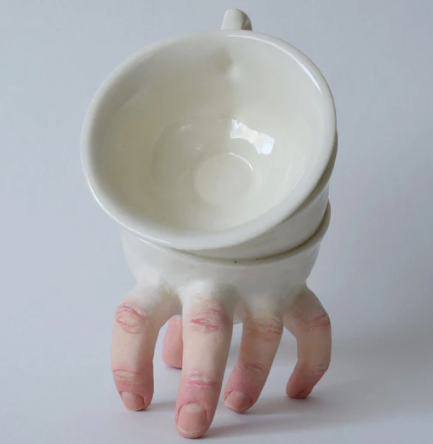
The experience itself, of having the tea, in these works, has been cut out like an unnecessary middleman, revealed for what he is, and in this way we are shown how some of the “incidental” features of the experience, such as the clean up (and if you are familiar with the service industry in America you will realize just how much goes on behind the scenes), are parts of a wider whole, which allows us to better appreciate what it is we deem valuable within the experience, as it enhances our understanding of how the experience actually unfolds — we thereby avoid the sort of myopia Aurelius wards against in his frothy boar-mouth passage.
I have only focused on a few pieces, and chose these ones because they seem to me most direct in how they relate to the themes of Stoicism and perceptual images. It must be remembered, however, that the philosophical dispute between Stoicism and Epicureanism lives on, and cannot be pushed aside or mysteriously dissolved upon entry into the realm of aesthetics. Epicureanism, not in the sense of voluptuous abandonment to the senses, but in the sense of simplicity distilled through the guise of refinement, persists as a problematic of the present collection, despite my focus on perceptual image. As with any art collection, Baranga’s sculptures are best considered in view of the whole, and I would encourage readers to contemplate the remaining pieces in the collection in light of Stoic philosophy as well as their own lives.



